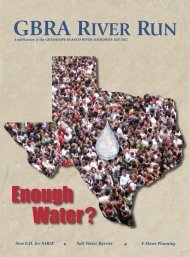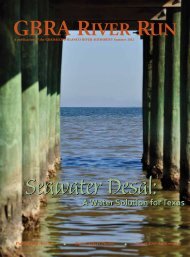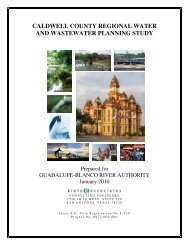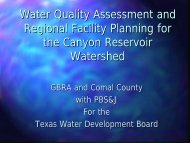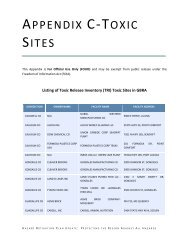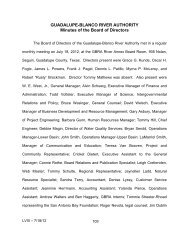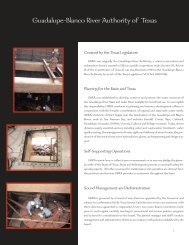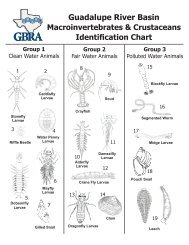Summer 2009 - Guadalupe-Blanco River Authority
Summer 2009 - Guadalupe-Blanco River Authority
Summer 2009 - Guadalupe-Blanco River Authority
- No tags were found...
Create successful ePaper yourself
Turn your PDF publications into a flip-book with our unique Google optimized e-Paper software.
Texas. According to the NationalWeather Service, the Pacific appearedto be warming in June and early July,returning to “El Nino,” a periodicwarming of the currents, which tendsto bring more rain to Texas.So it is possible to see increasedchances for precipitation asfall approaches.Meanwhile, one positive aspectof the drought is that scientists thistime were prepared to gather datafor understanding its effects and theeffects of future droughts."That will prove useful for thedevelopment of the Edwards AquiferRecovery Implementation Program(EARIP), which is charged withdeveloping a long-term environmentalplan for the aquifer", said RobertGulley, EARIP program manager.Photos by LaMarriol Smith“As the flow in the river goes down, more and more areas of the riverare cut off from the main flows,” Magin said. “Fish get trapped in theseisolated pools and die. It’s not because of anything toxic. It’s becauseof no oxygen being added.”The low flows combined with high temperatures also can promotethe growth of blue-green algae, which has an odor. Those areas ofwater also tend to have high levels of bacteria, which swimmers shouldavoid, and especially avoid diving and other activities that force waterinto the nasal passages, she said.“If there is a color to the water that’s not what they normally see, or ifthere is an odor, I would avoid that area,” Magin said. “They’ve got touse their understanding of how the water is supposed to be.”When the June rains didn’t come, the string of 100-degree days wasmaking its mark throughout the region.“One thing that has us concerned is that these are the kinds ofconditions you will typically encounter in August or September,” saidTodd Votteler, GBRA’s executive manager of intergovernmental relationsand policy. “We encountered this in June, usually a heavier rain period.It foreshadows that we could have a really bad summer.”“Droughts are normal,” said Norman Boyd, San Antonio Bayecosystem leader for the Texas Parks and Wildlife Department. “Theyare part of the territory. The concern is how long it’s going to be hereand how long the salinity is going to be high.”Most things return to normal after a drought ends, but some of theseafood populations may take a while to bounce back, Boyd explained,adding, “And that has an impact on the communities that depend onthose resources”Meteorologists generally attribute the drought to “La Nina,” a periodiccooling of the currents in the Pacific, which leads to dry periods in15Recreational tubers try to navigate down the <strong>Guadalupe</strong> <strong>River</strong> near Sattler where therelease rate from Canyon Reservoir was 61 cfs in mid-July.




